cooling INFINITI G-CONVERTIBLE 2012 Owners Manual
[x] Cancel search | Manufacturer: INFINITI, Model Year: 2012, Model line: G-CONVERTIBLE, Model: INFINITI G-CONVERTIBLE 2012Pages: 474, PDF Size: 3.63 MB
Page 201 of 474
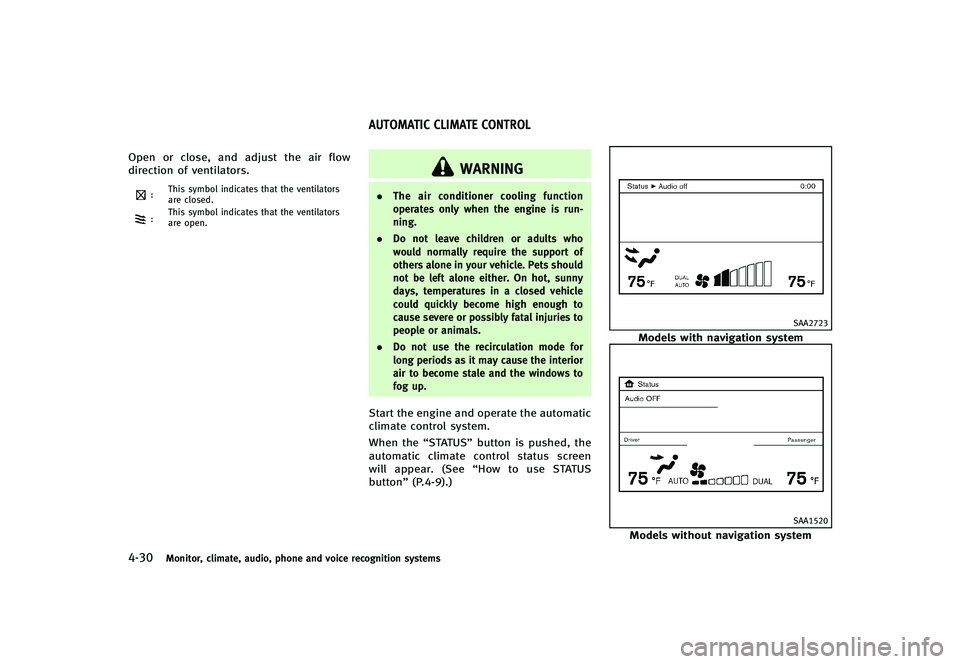
4-30Monitor, climate, audio, phone and voice recognition systems
Open or close, and adjust the air flow
direction of ventilators.
:This symbol indicates that the ventilators
are closed.
:This symbol indicates that the ventilators
are open.
GUID-4DAF5D1A-025C-43E9-98E9-33F7949A17A8
WARNING
.
The air conditioner cooling function
operates only when the engine is run-
ning.
. Do not leave children or adults who
would normally require the support of
others alone in your vehicle. Pets should
not be left alone either. On hot, sunny
days, temperatures in a closed vehicle
could quickly become high enough to
cause severe or possibly fatal injuries to
people or animals.
. Do not use the recirculation mode for
long periods as it may cause the interior
air to become stale and the windows to
fog up.
Start the engine and operate the automatic
climate control system.
When the “STATUS”button is pushed, the
automatic climate control status screen
will appear. (See “How to use STATUS
button” (P.4-9).)
SAA2723
Models with navigation system
SAA1520
Models without navigation system
AUTOMATIC CLIMATE CONTROL
Page 202 of 474
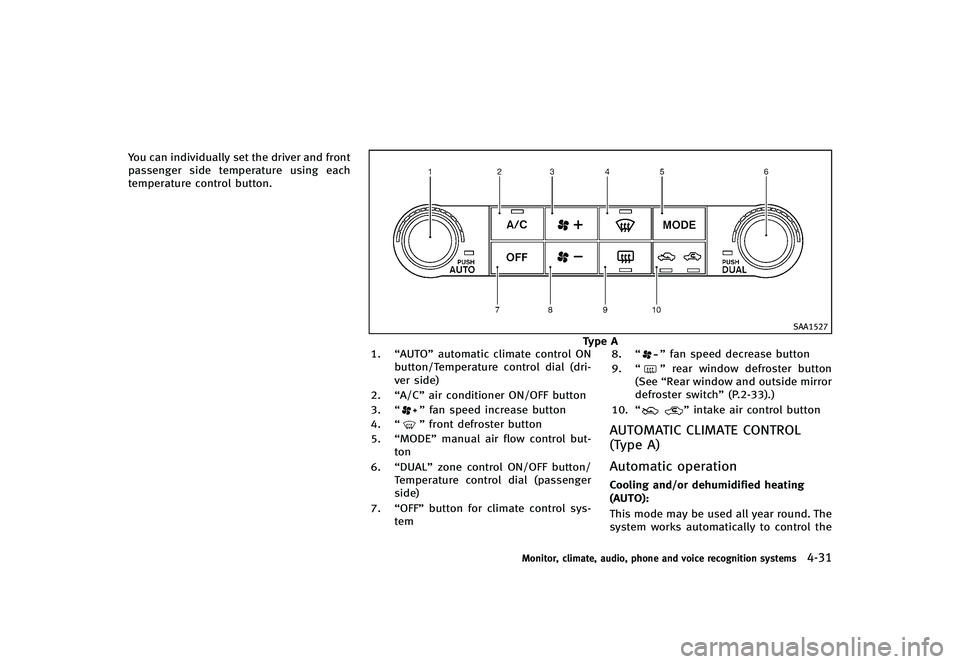
You can individually set the driver and front
passenger side temperature using each
temperature control button.
SAA1527
Type A
1. “AUTO” automatic climate control ON
button/Temperature control dial (dri-
ver side)
2. “A/C” air conditioner ON/OFF button
3. “
”fan speed increase button
4. “
”front defroster button
5. “MODE” manual air flow control but-
ton
6. “DUAL” zone control ON/OFF button/
Temperature control dial (passenger
side)
7. “OFF” button for climate control sys-
tem 8.
“
”fan speed decrease button
9. “
”rear window defroster button
(See “Rear window and outside mirror
defroster switch” (P.2-33).)
10. “
”intake air control button
AUTOMATIC CLIMATE CONTROL
(Type A)
GUID-A9101F1B-037E-4149-835E-8604F034756F
Automatic operationGUID-BB3B5174-0002-49A8-80C1-3587CBEF198FCooling and/or dehumidified heating
(AUTO):
GUID-D73A39BF-43C8-459F-9C24-47B7F579C407This mode may be used all year round. The
system works automatically to control the
Monitor, climate, audio, phone and voice recognition systems4-31
Page 205 of 474
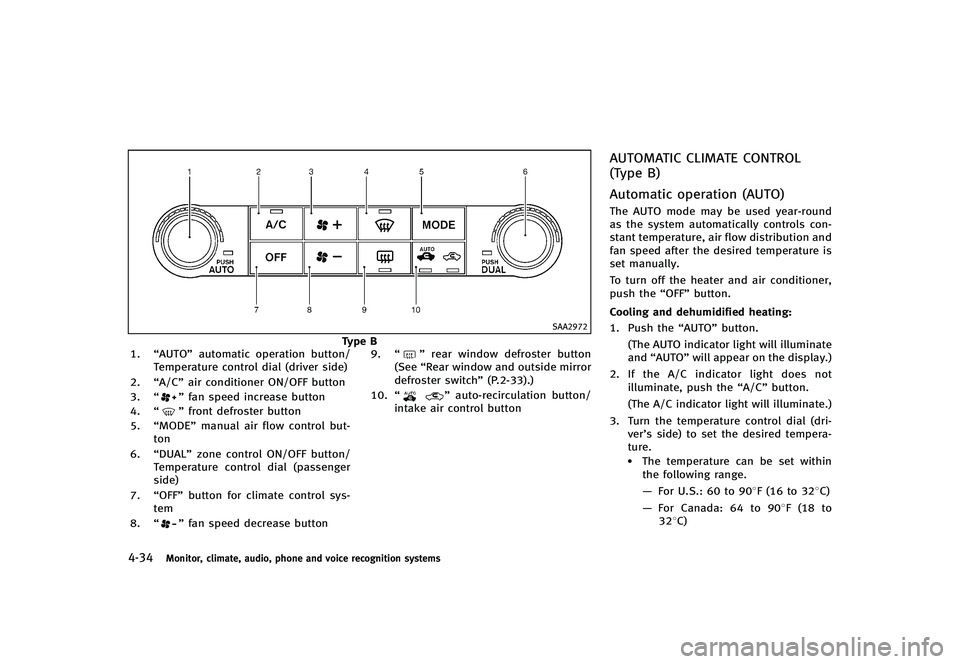
4-34Monitor, climate, audio, phone and voice recognition systems
SAA2972
Type B
1. “AUTO” automatic operation button/
Temperature control dial (driver side)
2. “A/C” air conditioner ON/OFF button
3. “
”fan speed increase button
4. “
”front defroster button
5. “MODE” manual air flow control but-
ton
6. “DUAL” zone control ON/OFF button/
Temperature control dial (passenger
side)
7. “OFF” button for climate control sys-
tem
8. “
”fan speed decrease button 9.
“
”rear window defroster button
(See “Rear window and outside mirror
defroster switch” (P.2-33).)
10. “
”auto-recirculation button/
intake air control button
AUTOMATIC CLIMATE CONTROL
(Type B)
GUID-5DF4AF3C-A6D9-4B2C-B9CC-1DB12FBCAB04
Automatic operation (AUTO)GUID-5C7B0530-32E5-4C67-A9C5-F917A7709924The AUTO mode may be used year-round
as the system automatically controls con-
stant temperature, air flow distribution and
fan speed after the desired temperature is
set manually.
To turn off the heater and air conditioner,
push the “OFF”button.
Cooling and dehumidified heating:
GUID-D73A39BF-43C8-459F-9C24-47B7F579C4071. Push the “AUTO”button.
(The AUTO indicator light will illuminate
and “AUTO” will appear on the display.)
2. If the A/C indicator light does not
illuminate, push the “A/C”button.
(The A/C indicator light will illuminate.)
3. Turn the temperature control dial (dri- ver’s side) to set the desired tempera-
ture.
.The temperature can be set withinthe following range.
— For U.S.: 60 to 908F (16 to 328C)
— For Canada: 64 to 908F (18 to
328C)
Page 365 of 474

5-56Starting and driving
stable surface.
. If wheels or tires other than the INFINITI
recommended ones are used, the VDC
system may not operate properly and
the VDC warning light
may illumi-
nate.
. The VDC system is not a substitute for
winter tires or tire chains on a snow
covered road.
GUID-B293D084-3604-45BD-A663-CF453888F902
FREEING A FROZEN DOOR LOCKGUID-2C882469-11A3-4715-8BCB-FA19FFE0887FTo prevent a door lock from freezing, apply
deicer through the key hole. If the lock
becomes frozen, heat the key before
inserting it into the key hole or use the
Intelligent Key system.
ANTIFREEZEGUID-C3261124-A271-4B19-A25E-63CCB5008F6AIn the winter when it is anticipated that the
outside temperature will drop below 328F
(08C), check antifreeze to assure proper
winter protection. For additional informa-
tion, see “Engine cooling system” (P.8-8).
BATTERYGUID-F9CBEBD7-C133-422D-A36C-05EFDC8A701EIf the battery is not fully charged during
extremely cold weather conditions, the
battery fluid may freeze and damage the
battery. To maintain maximum efficiency,
the battery should be checked regularly.
For additional information, see “Battery”
(P.8-15).
DRAINING OF COOLANT WATERGUID-52E88C59-7722-46BD-A12A-8762FEB37D9CIf the vehicle is to be left outside without
antifreeze, drain the cooling system, in-
cluding the engine block. Refill before
operating the vehicle. For details, see
“Engine cooling system” (P.8-8).
TIRE EQUIPMENTGUID-A19A4B63-2858-43F2-970D-016811637FE9SUMMER tires have a tread designed to
provide superior performance on dry pave-
ment. However, the performance of these
tires will be substantially reduced in snowy
and icy conditions. If you operate your
vehicle on snowy or icy roads, INFINITI
recommends the use of MUD & SNOW or
ALL SEASON tires on all four wheels.
Consult an INFINITI retailer for the tire
type, size, speed rating and availability
information.
For additional traction on icy roads,
studded tires may be used. However, some
U.S. states and Canadian provinces prohi-
bit their use. Check local, state and
provincial laws before installing studded
tires.
Skid and traction capabilities of studded
snow tires, on wet or dry surfaces, may be
poorer than that of non-studded snow
tires.
Tire chains may be used. For details, see
“Tire chains”(P.8-35) of this manual.
COLD WEATHER DRIVING
Page 381 of 474
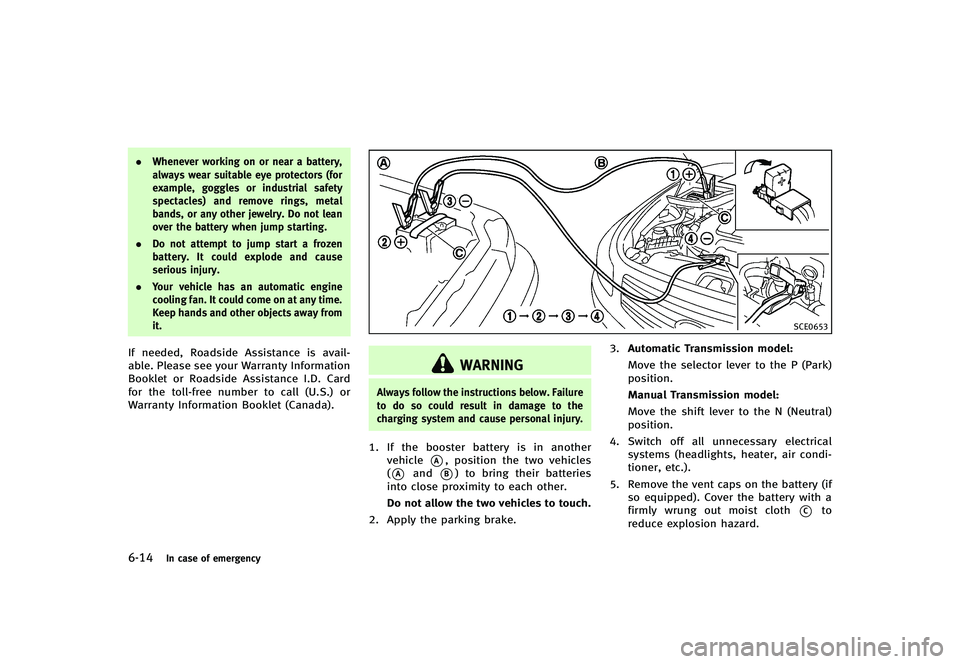
6-14In case of emergency
.Whenever working on or near a battery,
always wear suitable eye protectors (for
example, goggles or industrial safety
spectacles) and remove rings, metal
bands, or any other jewelry. Do not lean
over the battery when jump starting.
. Do not attempt to jump start a frozen
battery. It could explode and cause
serious injury.
. Your vehicle has an automatic engine
cooling fan. It could come on at any time.
Keep hands and other objects away from
it.
If needed, Roadside Assistance is avail-
able. Please see your Warranty Information
Booklet or Roadside Assistance I.D. Card
for the toll-free number to call (U.S.) or
Warranty Information Booklet (Canada).
SCE0653
WARNING
Always follow the instructions below. Failure
to do so could result in damage to the
charging system and cause personal injury.
1. If the booster battery is in another
vehicle
*A, position the two vehicles
(
*Aand*B) to bring their batteries
into close proximity to each other.
Do not allow the two vehicles to touch.
2. Apply the parking brake. 3.
Automatic Transmission model:
Move the selector lever to the P (Park)
position.
Manual Transmission model:
Move the shift lever to the N (Neutral)
position.
4. Switch off all unnecessary electrical
systems (headlights, heater, air condi-
tioner, etc.).
5. Remove the vent caps on the battery (if so equipped). Cover the battery with a
firmly wrung out moist cloth
*Cto
reduce explosion hazard.
Page 383 of 474

6-16In case of emergency
GUID-ACE17335-4E03-448D-9AFB-B5A07B6F0C0C
CAUTION
.Do not continue to drive if your vehicle
overheats. Doing so could cause engine
damage or a vehicle fire.
. To avoid the danger of being scalded,
never remove the radiator cap while the
engine is still hot. When the radiator cap
is removed, pressurized hot water will
spurt out, possibly causing serious
injury.
. Do not open the hood if steam is coming
out.
If your vehicle is overheating (indicated by
an extremely high temperature gauge
reading), or if you feel a lack of engine
power, detect abnormal noise, etc., take
the following steps:
1. Move the vehicle safely off the road,
apply the parking brake.
2. Automatic Transmission model:
Move the selector lever to the P (Park)
position.
Manual Transmission model:
Move the shift lever to the N (Neutral)
position. Do not stop the engine.
3. Turn off the air conditioner. Open all the windows, move the heater or air condi-
tioner temperature control to maximum
hot and fan control to high speed.
4. If engine overheating is caused by
climbing a long hill on a hot day, run
the engine at a fast idle (approximately
1,500 rpm) until the temperature gauge
indication returns to normal.
5. Get out of the vehicle. Look and listen for steam or coolant escaping from the
radiator before opening the hood. (If
steam or coolant is escaping, turn off
the engine.) Do not open the hood
further until no steam or coolant can be
seen.
6. Open the engine hood.
WARNING
If steam or water is coming from the engine,
stand clear to prevent getting burned.
7. Visually check the drive belt for damage or looseness. Also check if the cooling
fan is running. The radiator hoses and
radiator should not leak water. If cool- ant is leaking or the cooling fan does
not run, stop the engine.
WARNING
Be careful not to allow your hands, hair,
jewelry or clothing to come into contact
with, or get caught in, engine belts or the
engine cooling fan. The engine cooling fan
can start at any time.
8. After the engine cools down, check the
coolant level in the reservoir with the
engine running. Add coolant to the
reservoir if necessary. Have your vehi-
cle repaired at the nearest INFINITI
retailer.
If needed, Roadside Assistance is avail-
able. Please see your Warranty Information
Booklet or Roadside Assistance I.D. Card
for the toll-free number to call (U.S.) or
Warranty & Roadside Assistance Informa-
tion Booklet (Canada).
IF YOUR VEHICLE OVERHEATS
Page 388 of 474

.Never tow a vehicle using the vehicle tie
downs or recovery hooks.
. Always pull the cable straight out from
the front of the vehicle. Never pull on the
vehicle at an angle.
. Pulling devices should be routed so they
do not touch any part of the suspension,
steering, brake or cooling systems.
. Pulling devices such as ropes or canvas
straps are not recommended for use in
vehicle towing or recovery.
Rocking a stuck vehicleGUID-CAB6F3A9-C000-4766-AEE6-0D0457CAACBAIf your vehicle is stuck in sand, snow, mud,
etc., use the following procedure:
1. Turn off the Vehicle Dynamic Control
(VDC) system.
2. Make sure the area in front and behind the vehicle is clear of obstructions.
3. Turn the steering wheel right and left to clear an area around the front tires.
4. Slowly rock the vehicle forward and backward.
.Shift back and forth between R
(Reverse) and D (Drive) (automatic
transmission models) or 1st and R
(Reverse) (manual transmission models).
.Apply the accelerator as little as
possible to maintain the rocking
motion.
.Release the accelerator pedal beforeshifting between R (Reverse) and D
(Drive) (automatic transmission
models) or 1st and R (Reverse)
(manual transmission models).
.Do not spin the tires above 35 MPH(55 km/h).
5. If the vehicle cannot be freed after a few tries, contact a professional towing
service to remove the vehicle.
In case of emergency6-21
Page 398 of 474

8 Maintenance and do-it-yourself
Maintenance requirement...
.................................... 8-2
Scheduled maintenance ...
.................................. 8-2
General maintenance ...
....................................... 8-2
Where to go for service ...
................................... 8-2
General maintenance ...
........................................... 8-3
Explanation of maintenance items ...
................... 8-3
Maintenance precautions ...
..................................... 8-5
Engine compartment check locations ...
................... 8-7
VQ37VHR engine ...
............................................. 8-7
Engine cooling system ...
......................................... 8-8
Checking engine coolant level ...
......................... 8-9
Changing engine coolant ...
................................. 8-9
Engine oil ...
.......................................................... 8-10
Checking engine oil level ...
............................... 8-10
Changing engine oil and filter ...
....................... 8-10
Automatic transmission fluid ...
............................. 8-12
Power steering fluid ...
........................................... 8-13
Brake and clutch fluid ...
....................................... 8-13
Brake fluid ...
.................................................... 8-14
Clutch fluid (if so equipped) ...
.......................... 8-14
Window washer fluid ...
......................................... 8-14
Battery ...
.............................................................. 8-15
Jump starting ...
................................................ 8-17
Variable voltage control system ...
......................... 8-17 Drive belt
...
.......................................................... 8-17
Spark plugs ...
...................................................... 8-18
Replacing spark plugs ...
................................. 8-18
Air cleaner ...
........................................................ 8-19
Windshield wiper blades ...
................................... 8-20
Cleaning ...
...................................................... 8-20
Replacing ...
..................................................... 8-20
Brakes ...
.............................................................. 8-21
Self-adjusting brakes ...
................................... 8-21
Brake pad wear warning ...
.............................. 8-21
Fuses ...
................................................................ 8-22
Engine compartment ...
.................................... 8-22
Passenger compartment ...
............................... 8-23
Intelligent Key battery replacement ...
................... 8-24
Lights ...
................................................................ 8-26
Headlights ...
................................................... 8-26
Exterior and interior lights ...
........................... 8-27
Wheels and tires ...
............................................... 8-29
Tire pressure ...
............................................... 8-29
Tire labeling ...
................................................ 8-32
Types of tires ...
............................................... 8-34
Tire chains ...
................................................... 8-35
Changing wheels and tires ...
........................... 8-35
Page 402 of 474
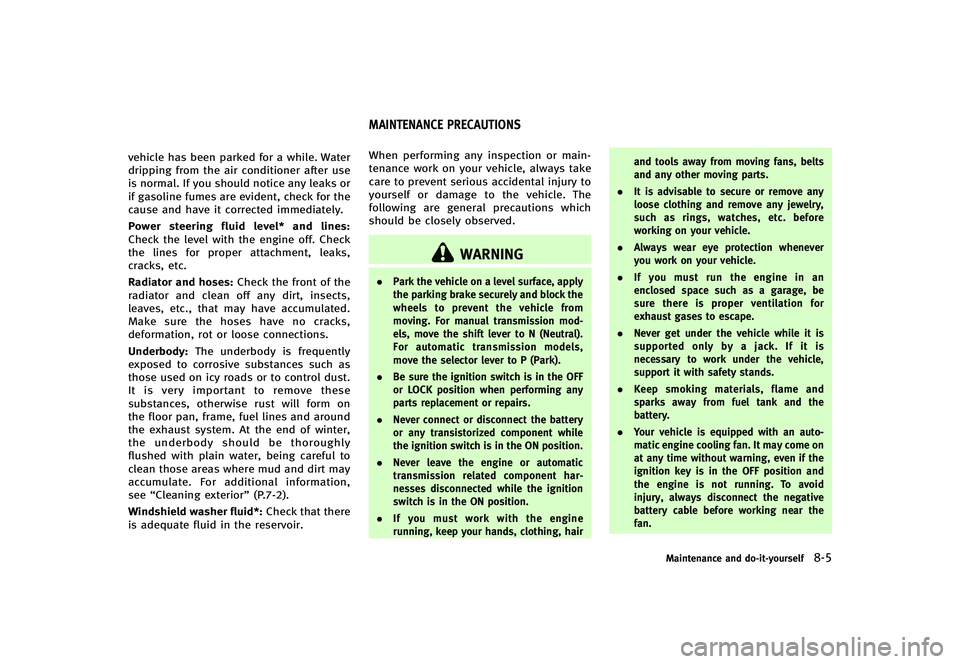
vehicle has been parked for a while. Water
dripping from the air conditioner after use
is normal. If you should notice any leaks or
if gasoline fumes are evident, check for the
cause and have it corrected immediately.
Power steering fluid level* and lines:
Check the level with the engine off. Check
the lines for proper attachment, leaks,
cracks, etc.
Radiator and hoses:Check the front of the
radiator and clean off any dirt, insects,
leaves, etc., that may have accumulated.
Make sure the hoses have no cracks,
deformation, rot or loose connections.
Underbody: The underbody is frequently
exposed to corrosive substances such as
those used on icy roads or to control dust.
It is very important to remove these
substances, otherwise rust will form on
the floor pan, frame, fuel lines and around
the exhaust system. At the end of winter,
the underbody should be thoroughly
flushed with plain water, being careful to
clean those areas where mud and dirt may
accumulate. For additional information,
see “Cleaning exterior” (P.7-2).
Windshield washer fluid*: Check that there
is adequate fluid in the reservoir.
GUID-10AF39EE-6E4C-416A-9D4D-B725EAC05CA0When performing any inspection or main-
tenance work on your vehicle, always take
care to prevent serious accidental injury to
yourself or damage to the vehicle. The
following are general precautions which
should be closely observed.
WARNING
. Park the vehicle on a level surface, apply
the parking brake securely and block the
wheels to prevent the vehicle from
moving. For manual transmission mod-
els, move the shift lever to N (Neutral).
For automatic transmission models,
move the selector lever to P (Park).
. Be sure the ignition switch is in the OFF
or LOCK position when performing any
parts replacement or repairs.
. Never connect or disconnect the battery
or any transistorized component while
the ignition switch is in the ON position.
. Never leave the engine or automatic
transmission related component har-
nesses disconnected while the ignition
switch is in the ON position.
. If you must work with the engine
running, keep your hands, clothing, hair and tools away from moving fans, belts
and any other moving parts.
. It is advisable to secure or remove any
loose clothing and remove any jewelry,
such as rings, watches, etc. before
working on your vehicle.
. Always wear eye protection whenever
you work on your vehicle.
. If you must run the engine in an
enclosed space such as a garage, be
sure there is proper ventilation for
exhaust gases to escape.
. Never get under the vehicle while it is
supported only by a jack. If it is
necessary to work under the vehicle,
support it with safety stands.
. Keep smoking materials, flame and
sparks away from fuel tank and the
battery.
. Your vehicle is equipped with an auto-
matic engine cooling fan. It may come on
at any time without warning, even if the
ignition key is in the OFF position and
the engine is not running. To avoid
injury, always disconnect the negative
battery cable before working near the
fan.
Maintenance and do-it-yourself8-5
MAINTENANCE PRECAUTIONS
Page 405 of 474
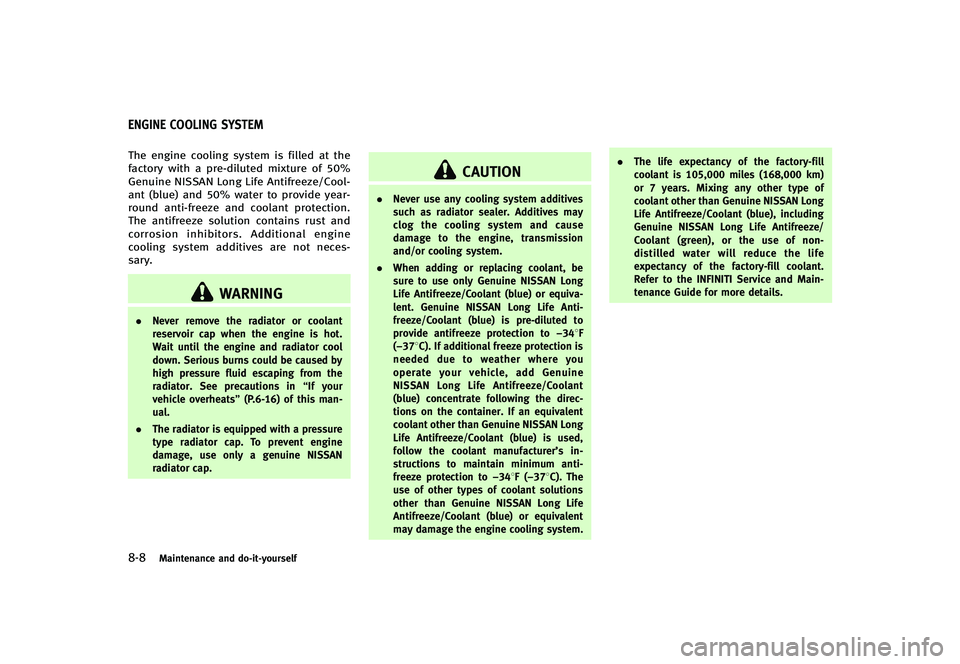
8-8Maintenance and do-it-yourself
GUID-EE54D4F6-5F4A-4B0F-A147-7A9330E7ABCFThe engine cooling system is filled at the
factory with a pre-diluted mixture of 50%
Genuine NISSAN Long Life Antifreeze/Cool-
ant (blue) and 50% water to provide year-
round anti-freeze and coolant protection.
The antifreeze solution contains rust and
corrosion inhibitors. Additional engine
cooling system additives are not neces-
sary.
WARNING
.Never remove the radiator or coolant
reservoir cap when the engine is hot.
Wait until the engine and radiator cool
down. Serious burns could be caused by
high pressure fluid escaping from the
radiator. See precautions in “If your
vehicle overheats” (P.6-16) of this man-
ual.
. The radiator is equipped with a pressure
type radiator cap. To prevent engine
damage, use only a genuine NISSAN
radiator cap.
CAUTION
.Never use any cooling system additives
such as radiator sealer. Additives may
clog the cooling system and cause
damage to the engine, transmission
and/or cooling system.
. When adding or replacing coolant, be
sure to use only Genuine NISSAN Long
Life Antifreeze/Coolant (blue) or equiva-
lent. Genuine NISSAN Long Life Anti-
freeze/Coolant (blue) is pre-diluted to
provide antifreeze protection to −348F
(−378C). If additional freeze protection is
needed due to weather where you
operate your vehicle, add Genuine
NISSAN Long Life Antifreeze/Coolant
(blue) concentrate following the direc-
tions on the container. If an equivalent
coolant other than Genuine NISSAN Long
Life Antifreeze/Coolant (blue) is used,
follow the coolant manufacturer’s in-
structions to maintain minimum anti-
freeze protection to −348F (−378C). The
use of other types of coolant solutions
other than Genuine NISSAN Long Life
Antifreeze/Coolant (blue) or equivalent
may damage the engine cooling system. .
The life expectancy of the factory-fill
coolant is 105,000 miles (168,000 km)
or 7 years. Mixing any other type of
coolant other than Genuine NISSAN Long
Life Antifreeze/Coolant (blue), including
Genuine NISSAN Long Life Antifreeze/
Coolant (green), or the use of non-
distilled water will reduce the life
expectancy of the factory-fill coolant.
Refer to the INFINITI Service and Main-
tenance Guide for more details.
ENGINE COOLING SYSTEM